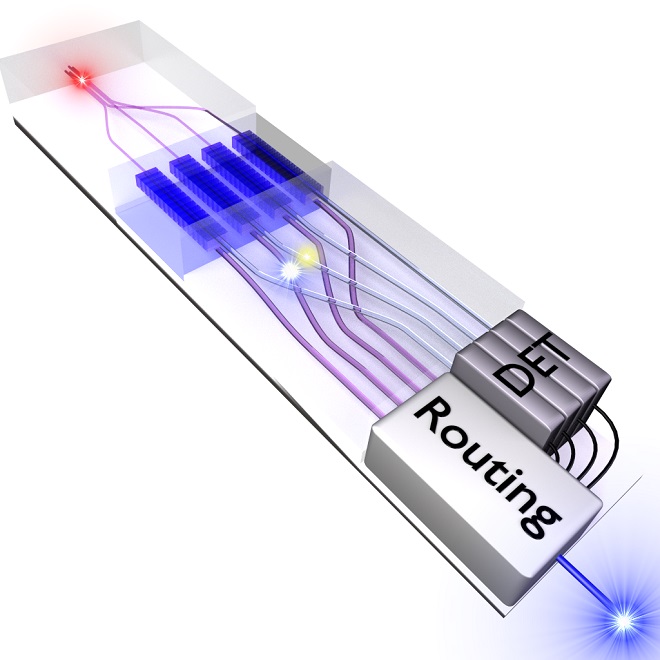31 March 2014
In the search for a single photon source, researchers in Australia and France have achieved a major step towards a turn-key source of individual, precisely tailored photons from an integrated optical chip.
A high quality source of single photons is vital for advances in quantum technologies including simulation of complex molecules, truly secure communication and ultimately quantum computation.
But as Macquarie PhD student and lead author Thomas Meany explains, “Unfortunately, nature is reluctant to create photons one at a time—they tend to come out in bunches. This is a serious impediment we have to overcome in order to make photon sources a useful tool.”
The work, reported in Laser & Photonics Reviews, involved collaboration between researchers from the ARC Centre of Excellence for Ultrahigh bandwidth Devices for Optical Systems (CUDOS) at Macquarie University and The University of Sydney, and a team from the Laboratoire de Physique de la Matière Condensée at the Université Nice Sophia Antipolis in Nice, France.
Since no single optical device can perform all the required operations, the international team tackled the problem using an approach of hybrid integration - combining different optical materials and components into one device in order to exploit the best of each technology.
They combined passive glass routers created by femtosecond laser writing, nonlinear waveguides in a highly advanced chip, and fast optical switching elements. The photons were generated in a lithium niobate chip developed in the group of Professor Sébastien Tanzilli and Dr Olivier Alibart at the Université Nice Sophia Antipolis. Femtosecond laser-written glass circuits produced at Macquarie were used to embed the Nice chip into the larger experiment.
“Our chip allows the generation of up to four photons simultaneously, but as they appear randomly, we can’t predict where or when the next photon will appear,” said Dr Alibart. “Further, lithium niobate is a wonderful nonlinear optical material, but it doesn’t interface easily with other components. The strategy of this collaboration was to use Macquarie’s laser-written waveguides both to deliver pump light to our chip and to guide the outgoing single photons towards the switching array that selects the correct output channel.”
In 2013, a landmark CUDOS experiment at the University of Sydney showed how to combine photons from two sources on a silicon chip, using ultrafast optical switches to break the intrinsic noise limit of photon sources. This new result shows that this approach is scalable – what works for a couple of sources can, excitingly, be extended to work with many – and can be applied to other types of waveguide, with more versatility in connecting different platforms.
“The laser-writing technology underlying this advance has numerous applications including quantum processing, as in this work, lasers for biology, and even the search for extra-solar planets” said Macquarie CUDOS Node director, Professor Michael Withford, who has been developing the writing technology for a decade.
“Our systems can build optical waveguides of almost arbitrary 3D form in simple glass chips. We continually find that because of this flexibility and ease of fabrication, femtosecond-written waveguides are perfect for connecting different optical systems to create a single functional device.”
Hybrid photonic circuit for multiplexed heralded single photons, T. Meany, L. A. Ngah, M. J. Collins, A. S. Clark, R. J. Williams, B. J. Eggleton, M. J. Steel, M. J. Withford, O. Alibart, and S. Tanzilli














